Emergency Use Authorization Policy Ending for EAU Medical Devices
Written-by: Sumeet Singh, CEO
FDA To Host Webinar to Establish Transition Framework for End to Temporary Emergency Use Authorization Policy and Enforcement Discretion for EUA Medical Devices
EUAs and Covid
Since the Covid-19 pandemic/Public Health Emergency for Covid-19 (PHE) was implemented, and in response to supply chain stress because of a lack of availability and the demand for certain devices intended to diagnose, treat, and prevent Covid-19 and associated conditions – including mitigating exposure to the SARS-Co-V-2 virus, FDA has authorized, and continues to authorize, more than 1,900 emergency use authorizations (EUAs) for medical devices (EUA Devices), under Section 564 of the FD&C Act. These EUA Devices are currently shielded under temporary FDA policies and enforcement discretion during the pandemic.
Temporary Protections Ending
FDA has announced that the EUA temporary protection policies and enforcement discretion will be coming to an end and has recently issued the following Draft Guidance documents recognizing that device manufacturers and other healthcare stakeholders will require time to adjust from the temporary policies adopted by FDA and to begin the process to facilitate an orderly and transparent transition back to normal operations for compliance once enforcement policies cease to be in effect:
- Transition Plan for Medical Devices That Fall Within Enforcement Policies Issued During the Coronavirus Disease 2019 (COVID-19) Public Health Emergency – Issued December 2021 https://www.fda.gov/media/155038/download
- Transition Plan for Medical Devices Issued Emergency Use Authorizations (EUAs) During the Coronavirus Disease 2019 (COVID-19) Public Health Emergency – Issued December 2021 https://www.fda.gov/media/155039/download
Transition Plan Framework
The Transition Plan Guidance documents introduce a three-phase framework that will begin with an announcement to manufacturers when the transition period begins and will be followed by a specific period in which manufacturers will need to prepare and submit applications for appropriate marketing authorization for EUA or EUA Devices. EUA or EUA Devices that are Class I or otherwise exempt from premarket notification requirements, do not need to comply with the marketing submission requirement. Once the transition period ends, manufacturers will be expected to be compliant with all applicable device regulations, including registration and listing, quality system requirements, unique device identifier (UDI), and labeling requirements.
FDA will not require market removal of the following types of EUA or EUA Devices before the end of the transition period:
- Single use, non-life supporting/life-sustaining devices that are consumed by the end user;
- Reusable, non-life supporting/life-sustaininging devices that are restored to their legally marketed versions or for which updated labeling accurately describing the product features and whether the device if FDA cleared or approved is made publicly available;
- Reusable, life-supporting/life-sustaining devices that are restored to their legally marketed versions or for which updated labeling accurately describing the product features and whether the device is FDA cleared or approved is made publicly available;
- In vitro diagnostic devices that are used for no more than the earlier of two years after the EUA termination date or the device expiration date.
Notification of Intent
FDA is recommending the manufacturers of certain reusable life-sustaining or life-supporting EUA or EUA Devices submit a “notification of intent” now to let them know whether or not a marketing application will be submitted so that the device can continue to be distributed. With that notification to FDA, manufacturers should also be including a transition implementation plan that provides the following information: 1) the estimated number of devices distributed; 2) a benefit-risk based plan for disposition of distributed devices if FDA issues a negative decision on the marketing application; and 3) plans for addressing distributed devices if FDA approves the marketing application.
3-Phase Transition
FDA’s proposed transition period may be divided as follows:
Phase 1 – to begin on the day of FDA’s announcement. Manufacturers will be required to begin complying with adverse event reporting requirements (CFR 21 Part 807) if they are not already doing so.
FDA will require manufacturers to begin complying with corrections and removals reporting requirements (CFR 21 Part 806) before Phase 2 begins. If a manufacturer plans to have an EUA Device distributed after the transition period, they must complete a registration and list the device with FDA before Phase 2 begins as well.
Phase 2 – to begin 90 days after the start date.
If the manufacturer does not have a submitted and accepted marketing application with FDA for the EUA Device before Phase 3 begins, or if the FDA issues a negative decision on a marketing application for the EUA Device, the manufacturer must discontinue the distribution of said EUA Device.
Phase 3 – to begin 180 days after the start date. Manufacturers will be required to be compliant with all applicable device regulations at the start of Phase 3, as FDA will withdraw the enforcement policies and enforcement discretion.
FDA plans to host a webinar on February 22, 2022 from 1:00 PM ET to 2:30 Pm ET for stakeholders interested in learning more about the Covid-19 transition plans for draft guidance for medical devices. Register at: https://www.fda.gov/medical-devices/workshops-conferences-medical-devices/webinar-draft-guidances-transition-plans-covid-19-related-medical-devices-02222022-02222022
Disclaimer: Pharma Solutions makes every effort to provide accurate information in the content it offers. However, the information provided is “as is” and Pharma Solutions makes no warranties, express or implied, as to the content provided. Pharma Solutions assumes no liability or responsibility for any errors or omissions in the content provided. Laws and regulations that are referenced herein may change over time and as such the content offered is not to be interpreted as advice. Pharma Solutions shall not be liable for any damages whatsoever incurred in connection with the use or performance of this information.




0 Comments